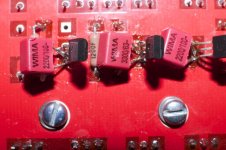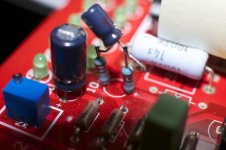I think Joachim is indanger...captive in kiev.....he needs money please give him your bank account information!!!
aahahahah.....just kidding....!! Joachim I think your email has been hacked in again. Somebody sent out emails to your contacts saying that you need money!!! I am sure he is fine...so please ppl don't respond with your information, this is a scam!!


aahahahah.....just kidding....!! Joachim I think your email has been hacked in again. Somebody sent out emails to your contacts saying that you need money!!! I am sure he is fine...so please ppl don't respond with your information, this is a scam!!


Boy am I slow… Finally got around to do this, on both boards, and they still oscillate. The photo below shows the oscillations, at 0.1 V per division.
B.t.w. I am testing without any load. Am I correct in assuming these should be stable without load?
One one of the board, I have changed every transistor except the two MOSFETs.
Sorry to bother folks with this...
Hi Pierre, did you install the caps in the shunt reg? Sorry I do not remember if you mentioned this earlier or not..... Also, would be interesting to know the frequency of the oscillations. Did you measure the supply rails?
The regulators should be stable without load, so that should make no difference. As a alast resort, you may want to change C105 / C205 for "bad" capacitors with a high ESR, or put 1Ohm resistors in series - if these caps are too good that can cause oscillation as well.
I think Joachim is indanger...captive in kiev.....he needs money please give him your bank account information!!!
aahahahah.....just kidding....!! Joachim I think your email has been hacked in again. Somebody sent out emails to your contacts saying that you need money!!! I am sure he is fine...so please ppl don't respond with your information, this is a scam!!

NO NO NO NO NO NO NO NO NO NO NO NO It's me that needs the money!!!

The regulators should be stable without load, so that should make no difference. As a alast resort, you may want to change C105 / C205 for "bad" capacitors with a high ESR, or put 1Ohm resistors in series - if these caps are too good that can cause oscillation as well.
I second that!
Hi Pierre, did you install the caps in the shunt reg? Sorry I do not remember if you mentioned this earlier or not..... Also, would be interesting to know the frequency of the oscillations. Did you measure the supply rails?
The regulators should be stable without load, so that should make no difference.
Yep, caps are installed. I tried various values between 680 and 3300 pF.
Oscillation frequencies are around 5 MHz with a 60+ MHz overlay.
Attachments
As a alast resort, you may want to change C105 / C205 for "bad" capacitors with a high ESR, or put 1Ohm resistors in series - if these caps are too good that can cause oscillation as well.
I second that!
Yep. Did this on one of the boards…
Attachments
Did you measure the supply rails?
Supply rails oscillate too, with greater amplitude (4x) than the regulated outputs.
Yep, caps are installed. I tried various values between 680 and 3300 pF.
Oscillation frequencies are around 5 MHz with a 60+ MHz overlay.
Hi Pierre,
try lower values for the compensation caps. In my setup (D45H11/D44H11/FQPF11/FPQF20, BC327/337 around 420 cause I didn't have any lower, SK170) I have to use 47pF/47pF on the outer BC's (Q104/204) and on the other board 47pF (positive) 147pF (negative) to get rid of the oscillations. I'm very suprised that there is only a small margin of compensation wich is successful. in three positions no comp and everything over 47pF (only had 100pF in my box) didn't work.
I didn't see any difference on the scope if I change the value of the inner caps - so I use 2,2nF, which I have at hand.
Maybe the following information is also useful for you: I have to use D45/D44. With SC5171/SA1930 (which I use before cause they are isolated) I also have had oscillations with similar amplitudes like you (~100mV ppk) and I#m not able to cure them.
galac
p.s. be sure to have no moving air or fan near the board when you scope it.
Hi Pierre,
try lower values for the compensation caps. […]
Hi Galac
Thank you for your detailed advice. Much appreciated. I will try lower cap values along the lines you suggest and report back.
Regards - Pierre
Supply rails oscillate too, with greater amplitude (4x) than the regulated outputs.
Try to test the CCS on it's own, take a 10 ohm resistor from the + or - 18V output to ground and measure current and see if there is still oscillation. If there is oscillation then the problem is in the CVS/CCS (top half) else the problem is in the shunt (bottom half) of the supply. While testing leave the pre-amp disconnected.
Try to test the CCS on it's own, take a 10 ohm resistor from the + or - 18V output to ground and measure current and see if there is still oscillation. If there is oscillation then the problem is in the CVS/CCS (top half) else the problem is in the shunt (bottom half) of the supply. While testing leave the pre-amp disconnected.
Just to be sure, you mean testing with a 10 ohm load?
Yes, the pre-amp remains disconnected, always.
where did you find this information?yes, 10 Ohm. That will create 120mW of power dissipation in the resistor, voltage across it should be 100mV or so. .............
100mV across 10r amounts to a dissipation of 1mW
1.1V across 10r gives a dissipation of ~120mW
1.1V across 10r gives a current of 110mA
there is conflicting information on what the correct size of the output inductor.Just a question on the Calvin buffers. I'm winding the inductor and I'll be buggered if i can get 10 turns of wire to get anywhere near 10uH, more like 0.5uH.
I'm already at 15 turns of .6mm wire over a 4mm former, shall I struggle on or is it not that important?
I went for 27T to match the 10uH requirement.
0.5uH is more suited to very low impedance loads, like 8ohms speaker.
4mm former is very small. Larger diameter gives larger inductance.
- Home
- Source & Line
- Analogue Source
- Paradise Builders

